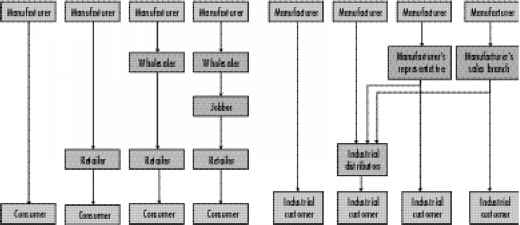Channel Levels
The producer and the final customer are part of every channel. We will use the number of intermediary levels to designate the length of a channel. Figure 5-3a illustrates several consumer-goods marketing channels of different lengths, while Figure 5-3b illustrates industrial marketing channels.
A zero-level channel (also called a direct-marketing channel) consists of a manufacturer selling directly to the final customer through Internet selling, door-to-door sales, home parties, mail order, telemarketing, TV selling, manufacturer-owned stores, and other methods. A one-level channel contains one selling intermediary, such as a retailer. A two-level channel contains two intermediaries; a three-level channel contains three intermediaries. From the producer's point of view, obtaining information about end users and exercising control becomes more difficult as the number of channel levels increases.
Channels normally describe a forward movement of products. One can also talk about backward channels, which recycle trash and old or obsolete products no longer used by customers. Several intermediaries play a role in backward channels, including
I» iwiwmr rrurtihrtf hiaim-i l>j |pU.gctrid mpi+tiHÎ
Üb J fcs ¡.lad ]A«I »y l\mt\ Ihr*
I» iwiwmr rrurtihrtf hiaim-i l>j |pU.gctrid mpi+tiHÎ

- Figure 5-3 Consumer and Industrial Marketing Channels
manufacturers' redemption centers, community groups, traditional intermediaries such as soft-drink intermediaries, trash-collection specialists, recycling centers, trash-recycling brokers, and central-processing warehousing.4
Continue reading here: Number of Intermediaries
Was this article helpful?